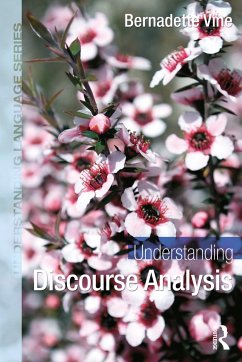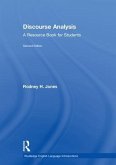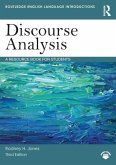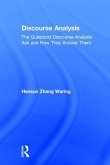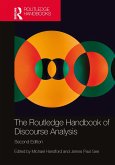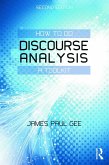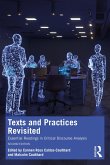Bernadette Vine
Understanding Discourse Analysis
Bernadette Vine
Understanding Discourse Analysis
- Broschiertes Buch
- Merkliste
- Auf die Merkliste
- Bewerten Bewerten
- Teilen
- Produkt teilen
- Produkterinnerung
- Produkterinnerung
Understanding Discourse Analysis provides students with an accessible and well-illustrated introduction to discourse analysis. Explaining the main terminology and frameworks and presenting key findings of discourse studies, this book: Explores the development of discourse analysisCovers four key approaches to analysing discourseUses authentic spoken or written texts in all examplesFeatures data from the Wellington Language in the Workplace Project databaseIncludes examples from a wide range of languages from around the world, such as Chilean Spanish, Korean and Serbo-Croatian Written by an…mehr
Andere Kunden interessierten sich auch für
![Discourse Analysis Discourse Analysis]() Rodney H. JonesDiscourse Analysis142,99 €
Rodney H. JonesDiscourse Analysis142,99 €![Discourse Analysis Discourse Analysis]() Rodney H. JonesDiscourse Analysis36,99 €
Rodney H. JonesDiscourse Analysis36,99 €![Discourse Analysis Discourse Analysis]() Hansun Zhang Waring (Teacher's College, Columbia University, USA)Discourse Analysis188,99 €
Hansun Zhang Waring (Teacher's College, Columbia University, USA)Discourse Analysis188,99 €![The Routledge Handbook of Discourse Analysis The Routledge Handbook of Discourse Analysis]() The Routledge Handbook of Discourse Analysis258,99 €
The Routledge Handbook of Discourse Analysis258,99 €![How to do Discourse Analysis How to do Discourse Analysis]() James Paul GeeHow to do Discourse Analysis60,99 €
James Paul GeeHow to do Discourse Analysis60,99 €![How to Do Discourse Analysis How to Do Discourse Analysis]() James Paul GeeHow to Do Discourse Analysis47,99 €
James Paul GeeHow to Do Discourse Analysis47,99 €![Texts and Practices Revisited Texts and Practices Revisited]() Texts and Practices Revisited73,99 €
Texts and Practices Revisited73,99 €-
-
-
Understanding Discourse Analysis provides students with an accessible and well-illustrated introduction to discourse analysis. Explaining the main terminology and frameworks and presenting key findings of discourse studies, this book:
Explores the development of discourse analysisCovers four key approaches to analysing discourseUses authentic spoken or written texts in all examplesFeatures data from the Wellington Language in the Workplace Project databaseIncludes examples from a wide range of languages from around the world, such as Chilean Spanish, Korean and Serbo-Croatian
Written by an active researcher, this textbook is a fascinating and engaging introduction to discourse analysis and is ideal for students studying this topic for the first time.
Explores the development of discourse analysisCovers four key approaches to analysing discourseUses authentic spoken or written texts in all examplesFeatures data from the Wellington Language in the Workplace Project databaseIncludes examples from a wide range of languages from around the world, such as Chilean Spanish, Korean and Serbo-Croatian
Written by an active researcher, this textbook is a fascinating and engaging introduction to discourse analysis and is ideal for students studying this topic for the first time.
Produktdetails
- Produktdetails
- Understanding Language
- Verlag: Routledge / Taylor & Francis
- Seitenzahl: 196
- Erscheinungstermin: 10. März 2023
- Englisch
- Abmessung: 234mm x 156mm x 11mm
- Gewicht: 294g
- ISBN-13: 9781032025889
- ISBN-10: 1032025883
- Artikelnr.: 66269895
- Herstellerkennzeichnung
- Libri GmbH
- Europaallee 1
- 36244 Bad Hersfeld
- gpsr@libri.de
- Understanding Language
- Verlag: Routledge / Taylor & Francis
- Seitenzahl: 196
- Erscheinungstermin: 10. März 2023
- Englisch
- Abmessung: 234mm x 156mm x 11mm
- Gewicht: 294g
- ISBN-13: 9781032025889
- ISBN-10: 1032025883
- Artikelnr.: 66269895
- Herstellerkennzeichnung
- Libri GmbH
- Europaallee 1
- 36244 Bad Hersfeld
- gpsr@libri.de
Bernadette Vine is Senior Researcher and Corpus Manager for the Language in the Workplace Project, based at the School of Linguistics and Applied Language Studies, Victoria University of Wellington, New Zealand (www.wgtn.ac.nz/lwp). Bernadette's research interests include workplace communication, leadership and New Zealand English.
Contents
Acknowledgements
Transcription Conventions
Part I Introducing Discourse Analysis
1 Introduction to Discourse Analysis
Introduction
1.2.1 Vocabulary
1.2.2 Syntax
1.2.3 Turn-taking
1.2.4 Summary
1.3 What are some of the things we do when we communicate?
1.3.1 What are some transactional or practical goals?
1.3.2 What about relational goals?
1.4 Language and identity
1.5 Outline of the rest of the book
Chapter summary
Further reading
Exercises
Notes on exercises
2 The foundations of Discourse Analysis
Introduction
2.1 The birth of discourse analysis
2.2 Speech Act Theory
2.2.1 What is Speech Act Theory?
2.2.2 Searle's taxonomy of speech acts
2.2.3 Why is Speech Act Theory useful?
2.3 Grice's cooperative principle, implicature and conversational maxims
2.3.1 Grice's cooperative principle and implicature
2.3.2 Grice's maxims of conversation
2.3.3 Why was Grice's work important?
2.4 Hymes' Ethnography of Communication, SPEAKING model
2.4.1 Hymes and the Ethnography of Communication
2.4.2 The SPEAKING model
2.4.3 The importance of Hymes' work
2.5 Leech's politeness theory
2.5.1 Leech's approach to politeness
2.5.2 Leech's maxims
2.5.3 The importance of Leech's work
2.6 Brown and Levinson's politeness theory
2.6.1 Brown and Levinson's approach to politeness
2.6.2 Key concept: Face
2.6.3 Threats to face
2.6.4 Politeness strategies
2.6.5 The importance of Brown and Levinson's theory
Chapter summary
Further reading
Exercises
Notes on exercises
Part II. Some key approaches to analysing discourse
3 Corpus Approaches to Discourse Analysis
Introduction
3.1 The origins and development of Corpus Approaches to Discourse Analysis
3.2 Introducing Corpus Approaches to Discourse Analysis
3.2.1 Some basic terms and concepts
3.2.2 Utilising corpora in discourse analysis research
3.3 Exploring words and phrases
3.3.1 Basic searches and exploring frequencies
3.3.2 Keywords and exploring distinctiveness
3.3.3 The use of phrases and formulaic language
3.3.4 Collocations and exploring words that frequently occur close to each other
3.3.5 Concordance lines and exploring the immediate discourse context further
3.3.6 Summary
3.4 Beyond words and phrases
3.5 Why take a Corpus Approach to Discourse Analysis?
Chapter summary
Further reading
Exercises
Notes on exercises
4 Conversation Analysis
Introduction
4.1 The origins and development of Conversation Analysis
4.2 What are some key concepts in Conversation Analysis?
4.2.1 Action and sequence
4.2.2 Turn-taking
4.2.3 Adjacency pairs
4.2.4 Sequence organisation
4.2.5 Preference
4.2.6 Repair
4.2.7 Summary
4.3 Beyond 'conversation': Institutional settings
4.3.1 Medical settings
4.3.2 Legal settings
4.3.3 Media settings
4.3.4 Summary
4.4 New mediums of communication
Chapter summary
Further reading
Exercises
Notes on exercises
5 Interactional Sociolinguistics
Introduction
5.1 The origins and development of Interactional Sociolinguistics
5.2 What are some key concepts in Interactional Sociolinguistics?
5.2.1 Contextualisation cues
5.2.2 Conversational inference
5.2.3 Framing
5.2.4 Norms and conversational style
5.2.5 Indexicality and stance
5.2.6 Summary
5.3 Some key topics in Interactional Sociolinguistics
5.3.1 The use of discourse strategies
5.3.2 The construction of routine encounters
5.3.3 The discursive creation of relationships
5.3.4 Identity
5.3.5 Summary
Chapter summary
Further reading
Exercises
Notes on exercises
6 Critical Discourse Studies
Introduction
6.1 The origins and development of Critical Discourse Studies
6.2 What are some key concepts in Critical Discourse Studies?
6.2.1 Power
6.2.2 Ideologies
6.2.3 What about the critical aspect of Critical Discourse Studies?
6.2.4 History
6.2.5 Summary
6.3 Key domains in Critical Discourse Studies
6.3.1 Political discourse
6.3.2 Media discourse
6.3.3 Summary
6.4 Types of analysis and methodologies in Critical Discourse Studies
6.4.1 Corpus linguistics and Critical Discourse Studies
6.4.2 Multimodal analysis in Critical Discourse Studies
Chapter summary
Further reading
Exercises
Notes on exercises
Part III. Conclusions and applications
7 Key approaches and applications
Introduction
7.1 Comparison of approaches
7.1.1 Types of data explored
7.1.2 Analytic approaches and methods
7.1.3 Issues explored
7.1.4 Summary
7.2 Applications of Discourse Analysis
7.2.1 Applied Conversation Analysis
7.2.2 Applications within Interactional Sociolinguistics
7.2.3 Applications and Critical Discourse Studies
7.2.4 Applying discourse analysis
Chapter summary
Further reading
Index
References
Acknowledgements
Transcription Conventions
Part I Introducing Discourse Analysis
1 Introduction to Discourse Analysis
Introduction
- Definitions
- What are some of the dimensions of discourse that may be explored?
1.1.1 What is discourse?
1.1.2 What is discourse analysis?
1.2.1 Vocabulary
1.2.2 Syntax
1.2.3 Turn-taking
1.2.4 Summary
1.3 What are some of the things we do when we communicate?
1.3.1 What are some transactional or practical goals?
1.3.2 What about relational goals?
1.4 Language and identity
1.5 Outline of the rest of the book
Chapter summary
Further reading
Exercises
Notes on exercises
2 The foundations of Discourse Analysis
Introduction
2.1 The birth of discourse analysis
2.2 Speech Act Theory
2.2.1 What is Speech Act Theory?
2.2.2 Searle's taxonomy of speech acts
2.2.3 Why is Speech Act Theory useful?
2.3 Grice's cooperative principle, implicature and conversational maxims
2.3.1 Grice's cooperative principle and implicature
2.3.2 Grice's maxims of conversation
2.3.3 Why was Grice's work important?
2.4 Hymes' Ethnography of Communication, SPEAKING model
2.4.1 Hymes and the Ethnography of Communication
2.4.2 The SPEAKING model
2.4.3 The importance of Hymes' work
2.5 Leech's politeness theory
2.5.1 Leech's approach to politeness
2.5.2 Leech's maxims
2.5.3 The importance of Leech's work
2.6 Brown and Levinson's politeness theory
2.6.1 Brown and Levinson's approach to politeness
2.6.2 Key concept: Face
2.6.3 Threats to face
2.6.4 Politeness strategies
2.6.5 The importance of Brown and Levinson's theory
Chapter summary
Further reading
Exercises
Notes on exercises
Part II. Some key approaches to analysing discourse
3 Corpus Approaches to Discourse Analysis
Introduction
3.1 The origins and development of Corpus Approaches to Discourse Analysis
3.2 Introducing Corpus Approaches to Discourse Analysis
3.2.1 Some basic terms and concepts
3.2.2 Utilising corpora in discourse analysis research
3.3 Exploring words and phrases
3.3.1 Basic searches and exploring frequencies
3.3.2 Keywords and exploring distinctiveness
3.3.3 The use of phrases and formulaic language
3.3.4 Collocations and exploring words that frequently occur close to each other
3.3.5 Concordance lines and exploring the immediate discourse context further
3.3.6 Summary
3.4 Beyond words and phrases
3.5 Why take a Corpus Approach to Discourse Analysis?
Chapter summary
Further reading
Exercises
Notes on exercises
4 Conversation Analysis
Introduction
4.1 The origins and development of Conversation Analysis
4.2 What are some key concepts in Conversation Analysis?
4.2.1 Action and sequence
4.2.2 Turn-taking
4.2.3 Adjacency pairs
4.2.4 Sequence organisation
4.2.5 Preference
4.2.6 Repair
4.2.7 Summary
4.3 Beyond 'conversation': Institutional settings
4.3.1 Medical settings
4.3.2 Legal settings
4.3.3 Media settings
4.3.4 Summary
4.4 New mediums of communication
Chapter summary
Further reading
Exercises
Notes on exercises
5 Interactional Sociolinguistics
Introduction
5.1 The origins and development of Interactional Sociolinguistics
5.2 What are some key concepts in Interactional Sociolinguistics?
5.2.1 Contextualisation cues
5.2.2 Conversational inference
5.2.3 Framing
5.2.4 Norms and conversational style
5.2.5 Indexicality and stance
5.2.6 Summary
5.3 Some key topics in Interactional Sociolinguistics
5.3.1 The use of discourse strategies
5.3.2 The construction of routine encounters
5.3.3 The discursive creation of relationships
5.3.4 Identity
5.3.5 Summary
Chapter summary
Further reading
Exercises
Notes on exercises
6 Critical Discourse Studies
Introduction
6.1 The origins and development of Critical Discourse Studies
6.2 What are some key concepts in Critical Discourse Studies?
6.2.1 Power
6.2.2 Ideologies
6.2.3 What about the critical aspect of Critical Discourse Studies?
6.2.4 History
6.2.5 Summary
6.3 Key domains in Critical Discourse Studies
6.3.1 Political discourse
6.3.2 Media discourse
6.3.3 Summary
6.4 Types of analysis and methodologies in Critical Discourse Studies
6.4.1 Corpus linguistics and Critical Discourse Studies
6.4.2 Multimodal analysis in Critical Discourse Studies
Chapter summary
Further reading
Exercises
Notes on exercises
Part III. Conclusions and applications
7 Key approaches and applications
Introduction
7.1 Comparison of approaches
7.1.1 Types of data explored
7.1.2 Analytic approaches and methods
7.1.3 Issues explored
7.1.4 Summary
7.2 Applications of Discourse Analysis
7.2.1 Applied Conversation Analysis
7.2.2 Applications within Interactional Sociolinguistics
7.2.3 Applications and Critical Discourse Studies
7.2.4 Applying discourse analysis
Chapter summary
Further reading
Index
References
Contents
Acknowledgements
Transcription Conventions
Part I Introducing Discourse Analysis
1 Introduction to Discourse Analysis
Introduction
1. Definitions
1.1.1 What is discourse?
1.1.2 What is discourse analysis?
2. What are some of the dimensions of discourse that may be explored?
1.2.1 Vocabulary
1.2.2 Syntax
1.2.3 Turn-taking
1.2.4 Summary
1.3 What are some of the things we do when we communicate?
1.3.1 What are some transactional or practical goals?
1.3.2 What about relational goals?
1.4 Language and identity
1.5 Outline of the rest of the book
Chapter summary
Further reading
Exercises
Notes on exercises
2 The foundations of Discourse Analysis
Introduction
2.1 The birth of discourse analysis
2.2 Speech Act Theory
2.2.1 What is Speech Act Theory?
2.2.2 Searle's taxonomy of speech acts
2.2.3 Why is Speech Act Theory useful?
2.3 Grice's cooperative principle, implicature and conversational maxims
2.3.1 Grice's cooperative principle and implicature
2.3.2 Grice's maxims of conversation
2.3.3 Why was Grice's work important?
2.4 Hymes' Ethnography of Communication, SPEAKING model
2.4.1 Hymes and the Ethnography of Communication
2.4.2 The SPEAKING model
2.4.3 The importance of Hymes' work
2.5 Leech's politeness theory
2.5.1 Leech's approach to politeness
2.5.2 Leech's maxims
2.5.3 The importance of Leech's work
2.6 Brown and Levinson's politeness theory
2.6.1 Brown and Levinson's approach to politeness
2.6.2 Key concept: Face
2.6.3 Threats to face
2.6.4 Politeness strategies
2.6.5 The importance of Brown and Levinson's theory
Chapter summary
Further reading
Exercises
Notes on exercises
Part II. Some key approaches to analysing discourse
3 Corpus Approaches to Discourse Analysis
Introduction
3.1 The origins and development of Corpus Approaches to Discourse Analysis
3.2 Introducing Corpus Approaches to Discourse Analysis
3.2.1 Some basic terms and concepts
3.2.2 Utilising corpora in discourse analysis research
3.3 Exploring words and phrases
3.3.1 Basic searches and exploring frequencies
3.3.2 Keywords and exploring distinctiveness
3.3.3 The use of phrases and formulaic language
3.3.4 Collocations and exploring words that frequently occur close to each
other
3.3.5 Concordance lines and exploring the immediate discourse context
further
3.3.6 Summary
3.4 Beyond words and phrases
3.5 Why take a Corpus Approach to Discourse Analysis?
Chapter summary
Further reading
Exercises
Notes on exercises
4 Conversation Analysis
Introduction
4.1 The origins and development of Conversation Analysis
4.2 What are some key concepts in Conversation Analysis?
4.2.1 Action and sequence
4.2.2 Turn-taking
4.2.3 Adjacency pairs
4.2.4 Sequence organisation
4.2.5 Preference
4.2.6 Repair
4.2.7 Summary
4.3 Beyond 'conversation': Institutional settings
4.3.1 Medical settings
4.3.2 Legal settings
4.3.3 Media settings
4.3.4 Summary
4.4 New mediums of communication
Chapter summary
Further reading
Exercises
Notes on exercises
5 Interactional Sociolinguistics
Introduction
5.1 The origins and development of Interactional Sociolinguistics
5.2 What are some key concepts in Interactional Sociolinguistics?
5.2.1 Contextualisation cues
5.2.2 Conversational inference
5.2.3 Framing
5.2.4 Norms and conversational style
5.2.5 Indexicality and stance
5.2.6 Summary
5.3 Some key topics in Interactional Sociolinguistics
5.3.1 The use of discourse strategies
5.3.2 The construction of routine encounters
5.3.3 The discursive creation of relationships
5.3.4 Identity
5.3.5 Summary
Chapter summary
Further reading
Exercises
Notes on exercises
6 Critical Discourse Studies
Introduction
6.1 The origins and development of Critical Discourse Studies
6.2 What are some key concepts in Critical Discourse Studies?
6.2.1 Power
6.2.2 Ideologies
6.2.3 What about the critical aspect of Critical Discourse Studies?
6.2.4 History
6.2.5 Summary
6.3 Key domains in Critical Discourse Studies
6.3.1 Political discourse
6.3.2 Media discourse
6.3.3 Summary
6.4 Types of analysis and methodologies in Critical Discourse Studies
6.4.1 Corpus linguistics and Critical Discourse Studies
6.4.2 Multimodal analysis in Critical Discourse Studies
Chapter summary
Further reading
Exercises
Notes on exercises
Part III. Conclusions and applications
7 Key approaches and applications
Introduction
7.1 Comparison of approaches
7.1.1 Types of data explored
7.1.2 Analytic approaches and methods
7.1.3 Issues explored
7.1.4 Summary
7.2 Applications of Discourse Analysis
7.2.1 Applied Conversation Analysis
7.2.2 Applications within Interactional Sociolinguistics
7.2.3 Applications and Critical Discourse Studies
7.2.4 Applying discourse analysis
Chapter summary
Further reading
Index
References
Acknowledgements
Transcription Conventions
Part I Introducing Discourse Analysis
1 Introduction to Discourse Analysis
Introduction
1. Definitions
1.1.1 What is discourse?
1.1.2 What is discourse analysis?
2. What are some of the dimensions of discourse that may be explored?
1.2.1 Vocabulary
1.2.2 Syntax
1.2.3 Turn-taking
1.2.4 Summary
1.3 What are some of the things we do when we communicate?
1.3.1 What are some transactional or practical goals?
1.3.2 What about relational goals?
1.4 Language and identity
1.5 Outline of the rest of the book
Chapter summary
Further reading
Exercises
Notes on exercises
2 The foundations of Discourse Analysis
Introduction
2.1 The birth of discourse analysis
2.2 Speech Act Theory
2.2.1 What is Speech Act Theory?
2.2.2 Searle's taxonomy of speech acts
2.2.3 Why is Speech Act Theory useful?
2.3 Grice's cooperative principle, implicature and conversational maxims
2.3.1 Grice's cooperative principle and implicature
2.3.2 Grice's maxims of conversation
2.3.3 Why was Grice's work important?
2.4 Hymes' Ethnography of Communication, SPEAKING model
2.4.1 Hymes and the Ethnography of Communication
2.4.2 The SPEAKING model
2.4.3 The importance of Hymes' work
2.5 Leech's politeness theory
2.5.1 Leech's approach to politeness
2.5.2 Leech's maxims
2.5.3 The importance of Leech's work
2.6 Brown and Levinson's politeness theory
2.6.1 Brown and Levinson's approach to politeness
2.6.2 Key concept: Face
2.6.3 Threats to face
2.6.4 Politeness strategies
2.6.5 The importance of Brown and Levinson's theory
Chapter summary
Further reading
Exercises
Notes on exercises
Part II. Some key approaches to analysing discourse
3 Corpus Approaches to Discourse Analysis
Introduction
3.1 The origins and development of Corpus Approaches to Discourse Analysis
3.2 Introducing Corpus Approaches to Discourse Analysis
3.2.1 Some basic terms and concepts
3.2.2 Utilising corpora in discourse analysis research
3.3 Exploring words and phrases
3.3.1 Basic searches and exploring frequencies
3.3.2 Keywords and exploring distinctiveness
3.3.3 The use of phrases and formulaic language
3.3.4 Collocations and exploring words that frequently occur close to each
other
3.3.5 Concordance lines and exploring the immediate discourse context
further
3.3.6 Summary
3.4 Beyond words and phrases
3.5 Why take a Corpus Approach to Discourse Analysis?
Chapter summary
Further reading
Exercises
Notes on exercises
4 Conversation Analysis
Introduction
4.1 The origins and development of Conversation Analysis
4.2 What are some key concepts in Conversation Analysis?
4.2.1 Action and sequence
4.2.2 Turn-taking
4.2.3 Adjacency pairs
4.2.4 Sequence organisation
4.2.5 Preference
4.2.6 Repair
4.2.7 Summary
4.3 Beyond 'conversation': Institutional settings
4.3.1 Medical settings
4.3.2 Legal settings
4.3.3 Media settings
4.3.4 Summary
4.4 New mediums of communication
Chapter summary
Further reading
Exercises
Notes on exercises
5 Interactional Sociolinguistics
Introduction
5.1 The origins and development of Interactional Sociolinguistics
5.2 What are some key concepts in Interactional Sociolinguistics?
5.2.1 Contextualisation cues
5.2.2 Conversational inference
5.2.3 Framing
5.2.4 Norms and conversational style
5.2.5 Indexicality and stance
5.2.6 Summary
5.3 Some key topics in Interactional Sociolinguistics
5.3.1 The use of discourse strategies
5.3.2 The construction of routine encounters
5.3.3 The discursive creation of relationships
5.3.4 Identity
5.3.5 Summary
Chapter summary
Further reading
Exercises
Notes on exercises
6 Critical Discourse Studies
Introduction
6.1 The origins and development of Critical Discourse Studies
6.2 What are some key concepts in Critical Discourse Studies?
6.2.1 Power
6.2.2 Ideologies
6.2.3 What about the critical aspect of Critical Discourse Studies?
6.2.4 History
6.2.5 Summary
6.3 Key domains in Critical Discourse Studies
6.3.1 Political discourse
6.3.2 Media discourse
6.3.3 Summary
6.4 Types of analysis and methodologies in Critical Discourse Studies
6.4.1 Corpus linguistics and Critical Discourse Studies
6.4.2 Multimodal analysis in Critical Discourse Studies
Chapter summary
Further reading
Exercises
Notes on exercises
Part III. Conclusions and applications
7 Key approaches and applications
Introduction
7.1 Comparison of approaches
7.1.1 Types of data explored
7.1.2 Analytic approaches and methods
7.1.3 Issues explored
7.1.4 Summary
7.2 Applications of Discourse Analysis
7.2.1 Applied Conversation Analysis
7.2.2 Applications within Interactional Sociolinguistics
7.2.3 Applications and Critical Discourse Studies
7.2.4 Applying discourse analysis
Chapter summary
Further reading
Index
References
Contents
Acknowledgements
Transcription Conventions
Part I Introducing Discourse Analysis
1 Introduction to Discourse Analysis
Introduction
1.2.1 Vocabulary
1.2.2 Syntax
1.2.3 Turn-taking
1.2.4 Summary
1.3 What are some of the things we do when we communicate?
1.3.1 What are some transactional or practical goals?
1.3.2 What about relational goals?
1.4 Language and identity
1.5 Outline of the rest of the book
Chapter summary
Further reading
Exercises
Notes on exercises
2 The foundations of Discourse Analysis
Introduction
2.1 The birth of discourse analysis
2.2 Speech Act Theory
2.2.1 What is Speech Act Theory?
2.2.2 Searle's taxonomy of speech acts
2.2.3 Why is Speech Act Theory useful?
2.3 Grice's cooperative principle, implicature and conversational maxims
2.3.1 Grice's cooperative principle and implicature
2.3.2 Grice's maxims of conversation
2.3.3 Why was Grice's work important?
2.4 Hymes' Ethnography of Communication, SPEAKING model
2.4.1 Hymes and the Ethnography of Communication
2.4.2 The SPEAKING model
2.4.3 The importance of Hymes' work
2.5 Leech's politeness theory
2.5.1 Leech's approach to politeness
2.5.2 Leech's maxims
2.5.3 The importance of Leech's work
2.6 Brown and Levinson's politeness theory
2.6.1 Brown and Levinson's approach to politeness
2.6.2 Key concept: Face
2.6.3 Threats to face
2.6.4 Politeness strategies
2.6.5 The importance of Brown and Levinson's theory
Chapter summary
Further reading
Exercises
Notes on exercises
Part II. Some key approaches to analysing discourse
3 Corpus Approaches to Discourse Analysis
Introduction
3.1 The origins and development of Corpus Approaches to Discourse Analysis
3.2 Introducing Corpus Approaches to Discourse Analysis
3.2.1 Some basic terms and concepts
3.2.2 Utilising corpora in discourse analysis research
3.3 Exploring words and phrases
3.3.1 Basic searches and exploring frequencies
3.3.2 Keywords and exploring distinctiveness
3.3.3 The use of phrases and formulaic language
3.3.4 Collocations and exploring words that frequently occur close to each other
3.3.5 Concordance lines and exploring the immediate discourse context further
3.3.6 Summary
3.4 Beyond words and phrases
3.5 Why take a Corpus Approach to Discourse Analysis?
Chapter summary
Further reading
Exercises
Notes on exercises
4 Conversation Analysis
Introduction
4.1 The origins and development of Conversation Analysis
4.2 What are some key concepts in Conversation Analysis?
4.2.1 Action and sequence
4.2.2 Turn-taking
4.2.3 Adjacency pairs
4.2.4 Sequence organisation
4.2.5 Preference
4.2.6 Repair
4.2.7 Summary
4.3 Beyond 'conversation': Institutional settings
4.3.1 Medical settings
4.3.2 Legal settings
4.3.3 Media settings
4.3.4 Summary
4.4 New mediums of communication
Chapter summary
Further reading
Exercises
Notes on exercises
5 Interactional Sociolinguistics
Introduction
5.1 The origins and development of Interactional Sociolinguistics
5.2 What are some key concepts in Interactional Sociolinguistics?
5.2.1 Contextualisation cues
5.2.2 Conversational inference
5.2.3 Framing
5.2.4 Norms and conversational style
5.2.5 Indexicality and stance
5.2.6 Summary
5.3 Some key topics in Interactional Sociolinguistics
5.3.1 The use of discourse strategies
5.3.2 The construction of routine encounters
5.3.3 The discursive creation of relationships
5.3.4 Identity
5.3.5 Summary
Chapter summary
Further reading
Exercises
Notes on exercises
6 Critical Discourse Studies
Introduction
6.1 The origins and development of Critical Discourse Studies
6.2 What are some key concepts in Critical Discourse Studies?
6.2.1 Power
6.2.2 Ideologies
6.2.3 What about the critical aspect of Critical Discourse Studies?
6.2.4 History
6.2.5 Summary
6.3 Key domains in Critical Discourse Studies
6.3.1 Political discourse
6.3.2 Media discourse
6.3.3 Summary
6.4 Types of analysis and methodologies in Critical Discourse Studies
6.4.1 Corpus linguistics and Critical Discourse Studies
6.4.2 Multimodal analysis in Critical Discourse Studies
Chapter summary
Further reading
Exercises
Notes on exercises
Part III. Conclusions and applications
7 Key approaches and applications
Introduction
7.1 Comparison of approaches
7.1.1 Types of data explored
7.1.2 Analytic approaches and methods
7.1.3 Issues explored
7.1.4 Summary
7.2 Applications of Discourse Analysis
7.2.1 Applied Conversation Analysis
7.2.2 Applications within Interactional Sociolinguistics
7.2.3 Applications and Critical Discourse Studies
7.2.4 Applying discourse analysis
Chapter summary
Further reading
Index
References
Acknowledgements
Transcription Conventions
Part I Introducing Discourse Analysis
1 Introduction to Discourse Analysis
Introduction
- Definitions
- What are some of the dimensions of discourse that may be explored?
1.1.1 What is discourse?
1.1.2 What is discourse analysis?
1.2.1 Vocabulary
1.2.2 Syntax
1.2.3 Turn-taking
1.2.4 Summary
1.3 What are some of the things we do when we communicate?
1.3.1 What are some transactional or practical goals?
1.3.2 What about relational goals?
1.4 Language and identity
1.5 Outline of the rest of the book
Chapter summary
Further reading
Exercises
Notes on exercises
2 The foundations of Discourse Analysis
Introduction
2.1 The birth of discourse analysis
2.2 Speech Act Theory
2.2.1 What is Speech Act Theory?
2.2.2 Searle's taxonomy of speech acts
2.2.3 Why is Speech Act Theory useful?
2.3 Grice's cooperative principle, implicature and conversational maxims
2.3.1 Grice's cooperative principle and implicature
2.3.2 Grice's maxims of conversation
2.3.3 Why was Grice's work important?
2.4 Hymes' Ethnography of Communication, SPEAKING model
2.4.1 Hymes and the Ethnography of Communication
2.4.2 The SPEAKING model
2.4.3 The importance of Hymes' work
2.5 Leech's politeness theory
2.5.1 Leech's approach to politeness
2.5.2 Leech's maxims
2.5.3 The importance of Leech's work
2.6 Brown and Levinson's politeness theory
2.6.1 Brown and Levinson's approach to politeness
2.6.2 Key concept: Face
2.6.3 Threats to face
2.6.4 Politeness strategies
2.6.5 The importance of Brown and Levinson's theory
Chapter summary
Further reading
Exercises
Notes on exercises
Part II. Some key approaches to analysing discourse
3 Corpus Approaches to Discourse Analysis
Introduction
3.1 The origins and development of Corpus Approaches to Discourse Analysis
3.2 Introducing Corpus Approaches to Discourse Analysis
3.2.1 Some basic terms and concepts
3.2.2 Utilising corpora in discourse analysis research
3.3 Exploring words and phrases
3.3.1 Basic searches and exploring frequencies
3.3.2 Keywords and exploring distinctiveness
3.3.3 The use of phrases and formulaic language
3.3.4 Collocations and exploring words that frequently occur close to each other
3.3.5 Concordance lines and exploring the immediate discourse context further
3.3.6 Summary
3.4 Beyond words and phrases
3.5 Why take a Corpus Approach to Discourse Analysis?
Chapter summary
Further reading
Exercises
Notes on exercises
4 Conversation Analysis
Introduction
4.1 The origins and development of Conversation Analysis
4.2 What are some key concepts in Conversation Analysis?
4.2.1 Action and sequence
4.2.2 Turn-taking
4.2.3 Adjacency pairs
4.2.4 Sequence organisation
4.2.5 Preference
4.2.6 Repair
4.2.7 Summary
4.3 Beyond 'conversation': Institutional settings
4.3.1 Medical settings
4.3.2 Legal settings
4.3.3 Media settings
4.3.4 Summary
4.4 New mediums of communication
Chapter summary
Further reading
Exercises
Notes on exercises
5 Interactional Sociolinguistics
Introduction
5.1 The origins and development of Interactional Sociolinguistics
5.2 What are some key concepts in Interactional Sociolinguistics?
5.2.1 Contextualisation cues
5.2.2 Conversational inference
5.2.3 Framing
5.2.4 Norms and conversational style
5.2.5 Indexicality and stance
5.2.6 Summary
5.3 Some key topics in Interactional Sociolinguistics
5.3.1 The use of discourse strategies
5.3.2 The construction of routine encounters
5.3.3 The discursive creation of relationships
5.3.4 Identity
5.3.5 Summary
Chapter summary
Further reading
Exercises
Notes on exercises
6 Critical Discourse Studies
Introduction
6.1 The origins and development of Critical Discourse Studies
6.2 What are some key concepts in Critical Discourse Studies?
6.2.1 Power
6.2.2 Ideologies
6.2.3 What about the critical aspect of Critical Discourse Studies?
6.2.4 History
6.2.5 Summary
6.3 Key domains in Critical Discourse Studies
6.3.1 Political discourse
6.3.2 Media discourse
6.3.3 Summary
6.4 Types of analysis and methodologies in Critical Discourse Studies
6.4.1 Corpus linguistics and Critical Discourse Studies
6.4.2 Multimodal analysis in Critical Discourse Studies
Chapter summary
Further reading
Exercises
Notes on exercises
Part III. Conclusions and applications
7 Key approaches and applications
Introduction
7.1 Comparison of approaches
7.1.1 Types of data explored
7.1.2 Analytic approaches and methods
7.1.3 Issues explored
7.1.4 Summary
7.2 Applications of Discourse Analysis
7.2.1 Applied Conversation Analysis
7.2.2 Applications within Interactional Sociolinguistics
7.2.3 Applications and Critical Discourse Studies
7.2.4 Applying discourse analysis
Chapter summary
Further reading
Index
References
Contents
Acknowledgements
Transcription Conventions
Part I Introducing Discourse Analysis
1 Introduction to Discourse Analysis
Introduction
1. Definitions
1.1.1 What is discourse?
1.1.2 What is discourse analysis?
2. What are some of the dimensions of discourse that may be explored?
1.2.1 Vocabulary
1.2.2 Syntax
1.2.3 Turn-taking
1.2.4 Summary
1.3 What are some of the things we do when we communicate?
1.3.1 What are some transactional or practical goals?
1.3.2 What about relational goals?
1.4 Language and identity
1.5 Outline of the rest of the book
Chapter summary
Further reading
Exercises
Notes on exercises
2 The foundations of Discourse Analysis
Introduction
2.1 The birth of discourse analysis
2.2 Speech Act Theory
2.2.1 What is Speech Act Theory?
2.2.2 Searle's taxonomy of speech acts
2.2.3 Why is Speech Act Theory useful?
2.3 Grice's cooperative principle, implicature and conversational maxims
2.3.1 Grice's cooperative principle and implicature
2.3.2 Grice's maxims of conversation
2.3.3 Why was Grice's work important?
2.4 Hymes' Ethnography of Communication, SPEAKING model
2.4.1 Hymes and the Ethnography of Communication
2.4.2 The SPEAKING model
2.4.3 The importance of Hymes' work
2.5 Leech's politeness theory
2.5.1 Leech's approach to politeness
2.5.2 Leech's maxims
2.5.3 The importance of Leech's work
2.6 Brown and Levinson's politeness theory
2.6.1 Brown and Levinson's approach to politeness
2.6.2 Key concept: Face
2.6.3 Threats to face
2.6.4 Politeness strategies
2.6.5 The importance of Brown and Levinson's theory
Chapter summary
Further reading
Exercises
Notes on exercises
Part II. Some key approaches to analysing discourse
3 Corpus Approaches to Discourse Analysis
Introduction
3.1 The origins and development of Corpus Approaches to Discourse Analysis
3.2 Introducing Corpus Approaches to Discourse Analysis
3.2.1 Some basic terms and concepts
3.2.2 Utilising corpora in discourse analysis research
3.3 Exploring words and phrases
3.3.1 Basic searches and exploring frequencies
3.3.2 Keywords and exploring distinctiveness
3.3.3 The use of phrases and formulaic language
3.3.4 Collocations and exploring words that frequently occur close to each
other
3.3.5 Concordance lines and exploring the immediate discourse context
further
3.3.6 Summary
3.4 Beyond words and phrases
3.5 Why take a Corpus Approach to Discourse Analysis?
Chapter summary
Further reading
Exercises
Notes on exercises
4 Conversation Analysis
Introduction
4.1 The origins and development of Conversation Analysis
4.2 What are some key concepts in Conversation Analysis?
4.2.1 Action and sequence
4.2.2 Turn-taking
4.2.3 Adjacency pairs
4.2.4 Sequence organisation
4.2.5 Preference
4.2.6 Repair
4.2.7 Summary
4.3 Beyond 'conversation': Institutional settings
4.3.1 Medical settings
4.3.2 Legal settings
4.3.3 Media settings
4.3.4 Summary
4.4 New mediums of communication
Chapter summary
Further reading
Exercises
Notes on exercises
5 Interactional Sociolinguistics
Introduction
5.1 The origins and development of Interactional Sociolinguistics
5.2 What are some key concepts in Interactional Sociolinguistics?
5.2.1 Contextualisation cues
5.2.2 Conversational inference
5.2.3 Framing
5.2.4 Norms and conversational style
5.2.5 Indexicality and stance
5.2.6 Summary
5.3 Some key topics in Interactional Sociolinguistics
5.3.1 The use of discourse strategies
5.3.2 The construction of routine encounters
5.3.3 The discursive creation of relationships
5.3.4 Identity
5.3.5 Summary
Chapter summary
Further reading
Exercises
Notes on exercises
6 Critical Discourse Studies
Introduction
6.1 The origins and development of Critical Discourse Studies
6.2 What are some key concepts in Critical Discourse Studies?
6.2.1 Power
6.2.2 Ideologies
6.2.3 What about the critical aspect of Critical Discourse Studies?
6.2.4 History
6.2.5 Summary
6.3 Key domains in Critical Discourse Studies
6.3.1 Political discourse
6.3.2 Media discourse
6.3.3 Summary
6.4 Types of analysis and methodologies in Critical Discourse Studies
6.4.1 Corpus linguistics and Critical Discourse Studies
6.4.2 Multimodal analysis in Critical Discourse Studies
Chapter summary
Further reading
Exercises
Notes on exercises
Part III. Conclusions and applications
7 Key approaches and applications
Introduction
7.1 Comparison of approaches
7.1.1 Types of data explored
7.1.2 Analytic approaches and methods
7.1.3 Issues explored
7.1.4 Summary
7.2 Applications of Discourse Analysis
7.2.1 Applied Conversation Analysis
7.2.2 Applications within Interactional Sociolinguistics
7.2.3 Applications and Critical Discourse Studies
7.2.4 Applying discourse analysis
Chapter summary
Further reading
Index
References
Acknowledgements
Transcription Conventions
Part I Introducing Discourse Analysis
1 Introduction to Discourse Analysis
Introduction
1. Definitions
1.1.1 What is discourse?
1.1.2 What is discourse analysis?
2. What are some of the dimensions of discourse that may be explored?
1.2.1 Vocabulary
1.2.2 Syntax
1.2.3 Turn-taking
1.2.4 Summary
1.3 What are some of the things we do when we communicate?
1.3.1 What are some transactional or practical goals?
1.3.2 What about relational goals?
1.4 Language and identity
1.5 Outline of the rest of the book
Chapter summary
Further reading
Exercises
Notes on exercises
2 The foundations of Discourse Analysis
Introduction
2.1 The birth of discourse analysis
2.2 Speech Act Theory
2.2.1 What is Speech Act Theory?
2.2.2 Searle's taxonomy of speech acts
2.2.3 Why is Speech Act Theory useful?
2.3 Grice's cooperative principle, implicature and conversational maxims
2.3.1 Grice's cooperative principle and implicature
2.3.2 Grice's maxims of conversation
2.3.3 Why was Grice's work important?
2.4 Hymes' Ethnography of Communication, SPEAKING model
2.4.1 Hymes and the Ethnography of Communication
2.4.2 The SPEAKING model
2.4.3 The importance of Hymes' work
2.5 Leech's politeness theory
2.5.1 Leech's approach to politeness
2.5.2 Leech's maxims
2.5.3 The importance of Leech's work
2.6 Brown and Levinson's politeness theory
2.6.1 Brown and Levinson's approach to politeness
2.6.2 Key concept: Face
2.6.3 Threats to face
2.6.4 Politeness strategies
2.6.5 The importance of Brown and Levinson's theory
Chapter summary
Further reading
Exercises
Notes on exercises
Part II. Some key approaches to analysing discourse
3 Corpus Approaches to Discourse Analysis
Introduction
3.1 The origins and development of Corpus Approaches to Discourse Analysis
3.2 Introducing Corpus Approaches to Discourse Analysis
3.2.1 Some basic terms and concepts
3.2.2 Utilising corpora in discourse analysis research
3.3 Exploring words and phrases
3.3.1 Basic searches and exploring frequencies
3.3.2 Keywords and exploring distinctiveness
3.3.3 The use of phrases and formulaic language
3.3.4 Collocations and exploring words that frequently occur close to each
other
3.3.5 Concordance lines and exploring the immediate discourse context
further
3.3.6 Summary
3.4 Beyond words and phrases
3.5 Why take a Corpus Approach to Discourse Analysis?
Chapter summary
Further reading
Exercises
Notes on exercises
4 Conversation Analysis
Introduction
4.1 The origins and development of Conversation Analysis
4.2 What are some key concepts in Conversation Analysis?
4.2.1 Action and sequence
4.2.2 Turn-taking
4.2.3 Adjacency pairs
4.2.4 Sequence organisation
4.2.5 Preference
4.2.6 Repair
4.2.7 Summary
4.3 Beyond 'conversation': Institutional settings
4.3.1 Medical settings
4.3.2 Legal settings
4.3.3 Media settings
4.3.4 Summary
4.4 New mediums of communication
Chapter summary
Further reading
Exercises
Notes on exercises
5 Interactional Sociolinguistics
Introduction
5.1 The origins and development of Interactional Sociolinguistics
5.2 What are some key concepts in Interactional Sociolinguistics?
5.2.1 Contextualisation cues
5.2.2 Conversational inference
5.2.3 Framing
5.2.4 Norms and conversational style
5.2.5 Indexicality and stance
5.2.6 Summary
5.3 Some key topics in Interactional Sociolinguistics
5.3.1 The use of discourse strategies
5.3.2 The construction of routine encounters
5.3.3 The discursive creation of relationships
5.3.4 Identity
5.3.5 Summary
Chapter summary
Further reading
Exercises
Notes on exercises
6 Critical Discourse Studies
Introduction
6.1 The origins and development of Critical Discourse Studies
6.2 What are some key concepts in Critical Discourse Studies?
6.2.1 Power
6.2.2 Ideologies
6.2.3 What about the critical aspect of Critical Discourse Studies?
6.2.4 History
6.2.5 Summary
6.3 Key domains in Critical Discourse Studies
6.3.1 Political discourse
6.3.2 Media discourse
6.3.3 Summary
6.4 Types of analysis and methodologies in Critical Discourse Studies
6.4.1 Corpus linguistics and Critical Discourse Studies
6.4.2 Multimodal analysis in Critical Discourse Studies
Chapter summary
Further reading
Exercises
Notes on exercises
Part III. Conclusions and applications
7 Key approaches and applications
Introduction
7.1 Comparison of approaches
7.1.1 Types of data explored
7.1.2 Analytic approaches and methods
7.1.3 Issues explored
7.1.4 Summary
7.2 Applications of Discourse Analysis
7.2.1 Applied Conversation Analysis
7.2.2 Applications within Interactional Sociolinguistics
7.2.3 Applications and Critical Discourse Studies
7.2.4 Applying discourse analysis
Chapter summary
Further reading
Index
References
"Those studying discourse analysis will love this book which is richly illustrated with examples from diverse languages and cultures. Using a delightfully reader-friendly style, Bernadette Vine adroitly introduces students to the major approaches and the most important figures in discourse analysis."
Janet Holmes, Victoria University of Wellington, New Zealand
"For anyone wanting to know how discourse analysis is done, and why it is done in different but related ways, Understanding Discourse Analysis will provide an excellent, practical guide. It is accessible, features authentic data from different contexts and languages, and is highly interactive."
Michael Handford, Cardiff University, UK
Janet Holmes, Victoria University of Wellington, New Zealand
"For anyone wanting to know how discourse analysis is done, and why it is done in different but related ways, Understanding Discourse Analysis will provide an excellent, practical guide. It is accessible, features authentic data from different contexts and languages, and is highly interactive."
Michael Handford, Cardiff University, UK

